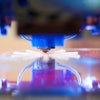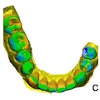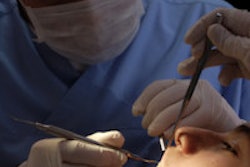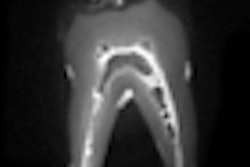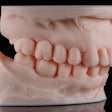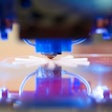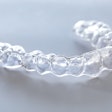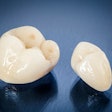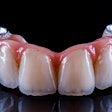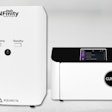
Three papers to be presented at the upcoming International Association for Dental Research (IADR) meeting in San Diego lend further support to the efficacy of the Canary photothermal imaging system for caries detection and for monitoring demineralization and remineralization of enamel.
Developed by researchers at the University of Toronto, the Canary uses frequency-domain photothermal radiometry (PTR) and modulated luminescence technology (LUM) to scan each tooth with low-power diode laser energy, measuring both the luminescence and the heat released from the tooth to identify the extent of decay.
The Canary system comprises a handheld device, a companion console, and a display that work together to deliver what the company calls a "Canary number," which provides an indication of the amount of attention that needs to be paid to each tooth that has been examined. The handset generates a low-power, near-infrared pulsating laser light that is used to scan teeth for the presence of tooth decay. As the laser light is shone onto a tooth, it is both absorbed and radiated back in two forms: light and heat.
By simultaneously measuring the luminescence of the reflected light and the heat created by the absorption of the laser energy by the tooth, the system is able to provide a user with information on the presence and extent of tooth decay at its surface and to a depth of 5 mm below it, according to Stephen Abrams, president and CEO of Quantum Dental Technologies, the company commercializing the device.
Previous studies illustrated the viability of the PTR-LUM technique, including a comparison of PTR-LUM with visual inspection, radiographs, and the Diagnodent (KaVo), found this technique had much higher sensitivity and specificity than the other techniques (Caries Research, November-December 2004, Vol. 38:6, pp. 497-513; Journal of Physics, 2010, Conference Series 214).
Clinical and preclinical research
The studies to be presented at the IADR meeting are an extension of this earlier work, both in clinical and preclinical settings.
One, designed to demonstrate the safety and efficacy of the Canary for detecting and monitoring tooth decay in vivo in a wide range of clinical scenarios seen in a typical dental practice, involved 150 subjects (18 years and older) from four dental clinics in Canada and Texas.
Practitioners used the system to record Canary numbers from various clinical conditions, including healthy surfaces, white and brown spots, early caries, hidden caries, interproximal caries, and demineralized and remineralized tooth surfaces.
The researchers found that PTR amplitude and PTR phase in the Canary number contributed to the detection of near-surface and subsurface lesions, while LUM amplitude and LUM phase contributed to the detection of near-surface lesions. The Canary number correlated with the severity of decay and the type, size, and nature of the lesion, and the system was able to track lesion activity over time after exposure to different remineralization agents.
"The present investigational study (QDT-201) corroborated and extended our findings from QDT-101: that the Canary system is safe and can discriminate between healthy and carious tooth surfaces," the researchers concluded.
Another study to be presented at the IADR meeting focused on the Canary's potential to monitor demineralization and remineralization of human enamel. The researchers collected 20 caries-free extracted human teeth, sectioned them mesiodistally into two parts, and divided them into 10 groups of four half-teeth each.
Demineralization was produced by subjecting the samples to a mixed Streptococcus mutans and Lactobacilli casei continuous flow biofilm model. Each group of teeth was scanned with the PTR-LUM before the demineralization; after 1, 3, 7, 10, and 14 days of demineralization; and after 10, 20, 30, 40, and 50 days of remineralization. Following each step of treatment, lesions were validated with transverse microradiography.
The PTR-LUM signals showed gradual changes with treatment time, the researchers found. The PTR amplitude and phase continuously increased with demineralization, then continuously decreased with the remineralization treatment, and the LUM signals exhibited similar behavior during remineralization, albeit with less contrast than PTR, they noted.
The third Canary study to be presented at IADR evaluated the Canary's potential to detect erosion lesions and their remineralization on human tooth enamel.
Five extracted caries-free human molars were painted with acid-resistant nail varnish, except a 1 x 4-mm window for treatment. Smooth-surface erosion lesions were created on the exposed window using freshly squeezed orange juice (pH 4.0). PTR-LUM frequency scans were performed before and after immersion in orange juice for 24 hours.
Following erosion treatments, lesions were exposed to an artificial remineralizing solution for seven days and scanned again with PTR-LUM. This was followed by the validation of the presence and nature of the lesions using transverse microradiography.
Again, PTR-LUM signals (amplitude and phase) showed consistent changes following the initial erosive challenge and its subsequent remineralization, the researchers found. In addition, the decrease in the PTR amplitude and phase signals was consistent with the onset of surface mineral loss after erosion, which reversed after being treated with the remineralizing solution.
"This proof-of-concept study demonstrated the capability of PTR-LUM to detect and monitor the progression and remineralization of early erosion lesions on enamel," the researchers concluded.
According to Abrams, Quantum is in the midst of regulatory approval and expects to have approval in Canada in April, EU in May, and U.S. Food and Drug Administration clearance for sale in the U.S. in late June or early July.


